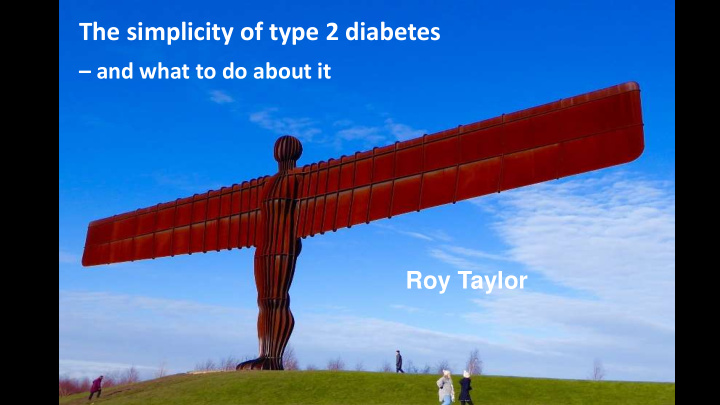



The simplicity of type 2 diabetes – and what to do about it Roy Taylor Roy Taylor Royal Victoria Infirmary Newcastle upon Tyne
Gradual beta cell Apoptosis death Islet amyloid Inflammation Gut hormones Genetic factors Brain regulation Muscle insulin resistance Microbiota Obesity Liver insulin Insulin signalling resistance
The twin cycle hypothesis Type 2 diabetes is a simple condition caused by too much fat in liver and pancreas Taylor R, Diabetologia 2008; 51: 1781
The twin cycle hypothesis Negative calorie balance in people with type 2 diabetes will: Pancreas Liver Decrease fat – Decrease fat – normalise the insulin improve insulin action and response to eating and normalise overnight blood sugar Taylor R, Diabetologia 2008; 51: 1781
Effect of very low calorie diet on fasting glucose The COUNTERPOINT study All hypoglycaemic agents stopped 10 Fasting plasma glucose 9.2 → 5.9 mmol/l ( p =0.003) At 7 days: 8 (mmol/l) 30% fall in liver fat Normalisation of liver insulin sensitivity 6 Over 8 weeks: 4 Gradual fall in pancreas fat Gradual return of first phase insulin response 0 2 4 6 8 Week Lim E-L et al, Diabetologia 2011; 54: 2506
The 2 nd study - Counterbalance: VLCD then 6 months normal eating Hepatic triglyceride (%) 16 Responders: 12 Liver fat (%) 8 * * * * 4 0 0 10w 6m 0 10w 6m Responders Non-Responders HbA1c (%) 7.1 5.8 5.9 Steven et al, Diabetes Care 2016; 39:808
DiRECT – a study in routine NHS General Practice Duration of T2DM less than 6 years; on oral agents and/or diet INTERVENTION 15kg weight loss then maintain 149 people 49 Practices CONTROL Best management by guidelines 149 people 0 12 months 24 months
Remissions by weight-loss category at 12 months Lean et al, Lancet 2017 391:541-51
Facilitators Behaviour-regulation strategies (examples) • Avoidance, • Reminding oneself of the goals • Distraction • Removing food from environment • Drinking water • Social disclosure Initial Adherence to the Total Diet Replacement Food motivation Interview 1 Interview 3 Interview 2 Emotional and cognitive Destabilisation Environmental barriers (baseline) (week 12-20) (week 6-8) barriers • Re-designing Presence of shops with food • Barriers • Traveling Life events and stress of the • • Going out and socializing Lack of social support “ Foodrobe ”
Non-obese cf. obese type 2 diabetes – Is the assumed difference in pathophysiology real? ? ? Non-obese T2DM have a greater beta cell defect and less insulin resistance Meal tests elicit similar insulin secretion (C-peptide rise of 2.5 fold in non-obese and 1.8 fold in obese) Reaven et al JCEM 1993; 76: 44 No greater insulin resistance in obese than non-obese T2DM relative to weight-matched control groups Hollenbeck et al Diabetes 1984; 33: 622
BMI distribution of individuals with type 2 diabetes 20 35 40 25 30 Taylor & Holman Clin Sci 2014
Personal vs population A Individuals B Individuals C Individuals 20 25 30 35 40 BMI Taylor & Holman Clin Sci 2014
An index patient 54y old diagnosed with type 2 diabetes: BMI 26.5; HbA1c 6.5%; Fasting glucose 7.2 “I do not want this. How can I get rid of it?” Advice. BMI HbA 1c FBG 6 mo 20.2 5.5 4.9 1y 19.4 5.3 4.8 14y 19.4 5.4 4.9
2013 Weight 126kg HbA1c 9.2% 2014: Weight 94kg HbA1c 6.2%
2017 Weight 83kg HbA1c 5.7% 2013 126.4kg 9.2% 2014 94kg 6.2% 2017 83kg 5.7%
Benefits to individuals • Feeling 10 years younger • Losing the ‘diabetic’ label • No diabetes tablets/injections • Outlook for long term health • Less time at the doc’s • No excess insurance costs Rehovaka et al Diabetic Medicine 2018
Summary Liver fat ↑ Liver fat ↓ Liver fat export ↑ Liver fat export ↓ VLDL VLDL Pancreas fat ↑ Pancreas fat ↓ Beta cell damage Beta cell damage ↑ ↓
Type 2 diabetes is a simple state of having more fat than the individual can tolerate
Recommend
More recommend